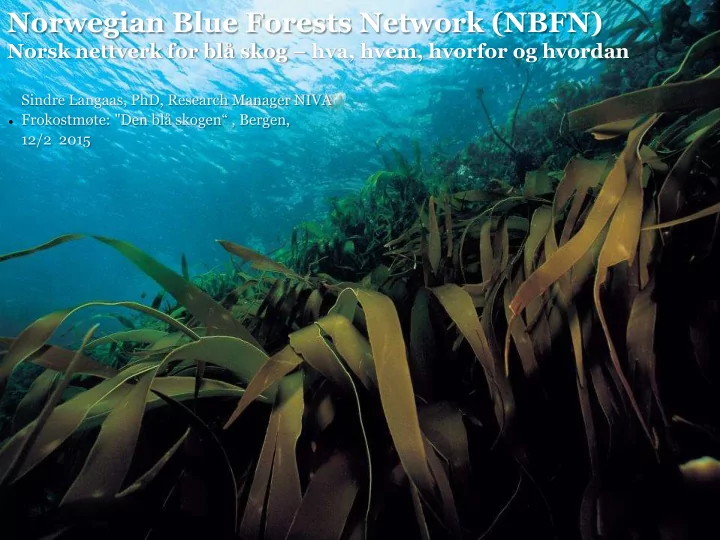

Norwegian Blue Forests Network (NBFN) Norsk nettverk for blå skog – hva, hvem, hvorfor og hvordan Sindre Langaas, PhD, Research Manager NIVA . Frokostmøte: "Den blå skogen “ , Bergen, 12/2 2015
What (definitions of blue forests and blue carbon ) • Blue forests: o Marine and coastal ecosystems that are particularly valuable through their provision of multiple ecosystem services, of which carbon sequestration is one • Blue carbon: o Carbon stored, sequestered or released from coastal ecosystems such as, but not limited to, tidal marshes, mangroves, seagrass meadows and kelp forests.
What (Global distribution of mangroves and kelp forests)
What ( blue forests and blue carbon ) • The ability to assimilate and store atmospheric carbon is shared by all marine ecosystems but some marine ecosystems are particularly good at doing this. • Mangroves, seagrass ecosystems and saltmarshes in tropical areas account for more than 50 % of all carbon storage in ocean sediments; despite they only cover 0.5 % of the sea bed. In the northern hemisphere, kelp forests are particularly important. Kelp forests are found along most of the Norwegian coast. • Blue Carbon is being recognized as important by the UN Framework Convention on Climate Change (UN FCCC) and the Intergovernmental Panel on Climate Change (IPCC), not at least due to the ability to sequester vast amounts of carbon — up to five times that stored in tropical forests. • These ecosystems are also crucial in their provisioning of severalother important ecosystem services • THIS IS NOT SUFFICIENTLY RECOGNISED TODAY IN SOCIETY ; IMPORTANT KNOWLEDGE IS STILL MISSING AND ITS FULL INCLUSION IN CLIMATE POLICIES IS STILL IN ITS INFANCY
What (The Norwegian Blue Forests Network (NBFN) • NBFN aims to jointly strengthen the Norwegian competence and know-how in blue forests matters so that its full potential in mitigation of climate change and provisioning of other ecosystem services can be met nationally and abroad
Who (presently)
How I. Raise awareness in Norway on the role of blue forests in capturing and the long- term storage of atmospheric carbon dioxide and their role in providing multiple other important ecosystem services II. Conduct research to contribute to increased knowledge on the role of blue forests, nationally and globally, in mitigation of climate change and as producer of a wide range of ecosystem services. III. Initiate and execute action oriented projects, in Norway and elsewhere, aiming to conserve, manage and sustainably use blue forests. IV. Support the Norwegian blue forests and blue carbon policy and research agenda and its implementation nationally and internationally, under the various international climate and biodiversity conventions and mechanisms, as well as those with a national focus requested by the Parliament, Government and sub- ordinated agencies
Membership & modus operandi • NBFN is open to knowledge-based organizations which are registered in Norway that work with blue carbon and blue forest issues towards the aim and objectives of NBFN. • NBFN works in a pragmatic, efficient and effective away, within the frames given by the internal and external resources available. The network aims to stimulate investment so that more resources are allocated for such activities. The network members agree to first seek partnerships from within the network on new initiatives relevant to the purpose of the network
Further information • Sindre Langaas, NIVA, tel 98227747, sindre.langaas@niva.no
Recommend
More recommend